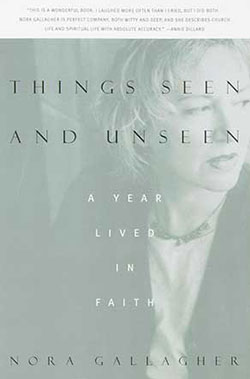Excerpt from Things Seen and Unseen
A Year Lived in Faith
In the beginning, I would go to church and cry. I spent a year crying in church. I couldn’t say the Nicene Creed. I refused to pledge, to promise a monthly sum to the church. I made myself as invisible as possible in the church and the church, an upper-class parish in Pacific Heights in San Francisco, took little notice of me. I did kneel at the rail with the other communicants, and take the sacrament. Then I returned to my pew, to kneel and cry again. Very often, I didn’t know what I was doing there. Many layers of feeling, experience and habit had to come together before I understood religious faith, including my own. I felt at first as if I were learning a new language or how to dance: I was so awkward and foolish that at every turn I wanted to quit.
Why did I cry so much? Apparently, many people who return to church or discover it later in their lives, end up crying in the pews. At the time I understood my tears psychologically - that is, I understood them to be about something unresolved in myself and I took myself to a therapist. Now I understand those tears both psychologically and religiously, different ways of understanding or different when the psychological is understood to be about something one can fix, rather than about something one can make room for. A friend of mine, a writer, once said he had no gift for religion. A friend of his, a believer, told him not to worry, God would find him. In religious terms, I was lost and on the verge of being found.
I loved the ritual, the cross held high before the lines of choir, the swinging incense, the bowing and kneeling. I loved the liturgy of the Episcopal Church: each week, each Mass, the same form, from the Book of Common Prayer. Each Sunday morning the service began with a hymn, then the opening acclamation, said by the priest: “Blessed be God: Father, Son, and Holy Spirit.” To which the people responded, “And blessed be his kingdom, now and forever. Amen.” Then what is called the Collect of Purity: “Almighty God, unto whom all hearts are open, all desires known, and from whom no secrets are hid. Cleanse the thoughts of our hearts...”
The trouble was, I didn’t believe that it was about anything real. I went to church as if it were a ballet. I went to the ballet on Sunday, felt many different kinds of feelings, couldn’t bring those feelings into line with my intellect or figure out how to integrate those feelings into my own experience and so gradually they faded as the week wore on. It didn’t connect. I suspect that many people who faithfully attend church remain in such a state and don’t know what to do about it. (And those who watch us from the outside, wonder, rightly, What’s the point of all this?) What I finally understood was that simply going to church doesn’t do it, but neither does not going to church.
It takes a long time to understand what is being asked, and who is doing the asking. Part of the problem is that we do not want to hear the voice or understand the message. In a sermon at Mt. Calvary monastery, Roy Parker, a lean monk whose running shoes poke out from beneath his robes, said that the presence of God was like a bit he’d seen on Candid Camera. The camera crew had arranged a large terra-cotta pot next to a table in a restaurant. In the pot was a trick plastic plant that would “grow” suddenly when someone sat down. A woman arrived and was seated.
“So she’s sitting there and the cameras are on her and suddenly the plant starts growing and she looks at it, bug-eyed, and then she looks furtively around, as we all might do, to see if anyone else has seen it and when she sees that they haven’t - they are just eating and talking - she moves to another table.
“When we are visited by grace,” Roy concluded, “and everyone else is just eating and talking, we tend to move to another table.”
That year, I was torn between dealing with God and my own habit of moving to another table.

Buy this book:
Amazon
Barnes & Noble
IndieBound
If you’d like to order books for resale, please contact Random House customer service for information on minimum order and competitive sales terms. Random House ships free freight.
Please call 1-800-733-3000 or email